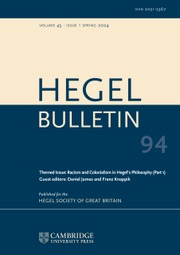Article contents
Hegel, Humour, and the Ends of Art
Published online by Cambridge University Press: 22 April 2013
Abstract
Art plays a fundamental role in Hegel's mature systematic philosophy, one of three principal forms of what Hegel terms ‘absolute spirit’, that is, a primary way in which humans cognize their nature and its role in the world (HW 10: 366-67). Notwithstanding this, Hegel's philosophy of art has received less attention than have his philosophy of religion, political philosophy, or philosophy of history, all of which were mainstays in the debates between the rival schools of Hegelianism directly after Hegel's death, and each of which exercised considerable authority in the nineteenth and twentieth centuries. There were no Right or Left Hegelians on questions of art. Of course, this is not to say that Hegel's philosophy of history and conception of dialectical reason did not have decisive impact on the founding of systematic art history and on the philosophy of art in the humanistic Marxism of Lukács, Adorno and Marcuse, but his specific views on aesthetics and the nature and history of the various arts were much less influential. If one were to broaden the scope of influence to include artists, Hegel is hardly worth mentioning next to figures like Schopenhauer and Nietzsche.
Do Hegel's specific views on art have purchase nowadays? One set of doctrines has received a good deal of attention, at least among philosophers of art: Hegel's claim that art has ‘ended’. Much commentary focuses on Hegel's contentions that (A) the art of Attic Greece was the primary way for that culture to experience their form of life as binding, and that (B) art after a point in that culture can never play that role again, at least not progressively.
- Type
- Research Article
- Information
- Bulletin of the Hegel Society of Great Britain , Volume 31 , Special Issue 2: Special Issue on Hegel and Literature , Autumn/Winter 2010 , pp. 1 - 22
- Copyright
- Copyright © The Hegel Society of Great Britain 2010
References
- 1
- Cited by


